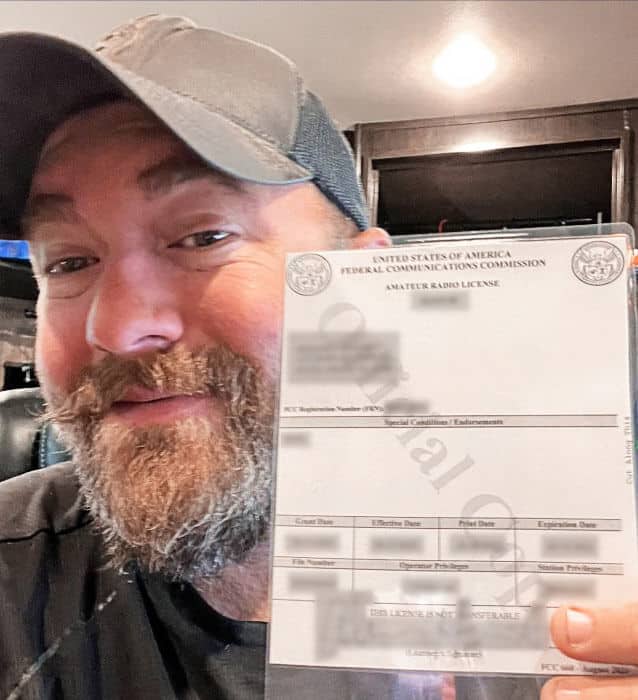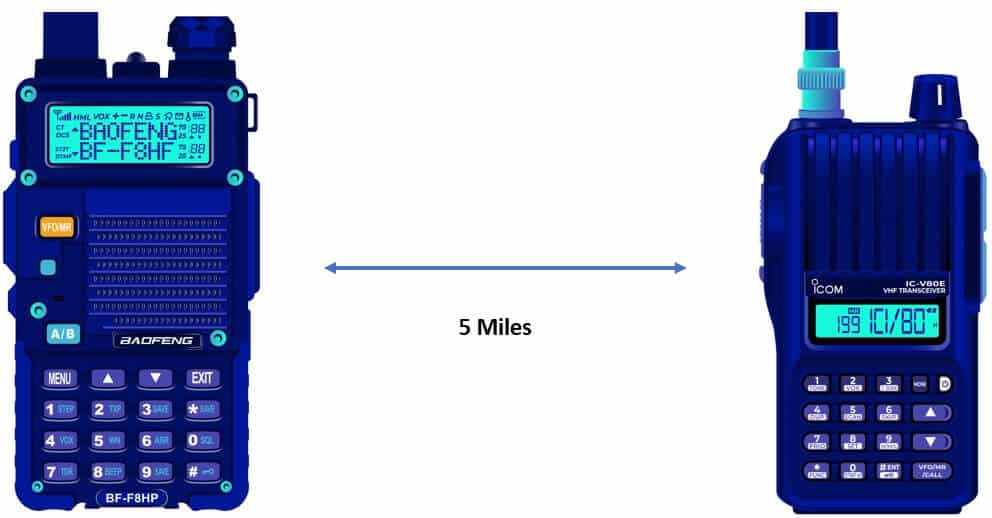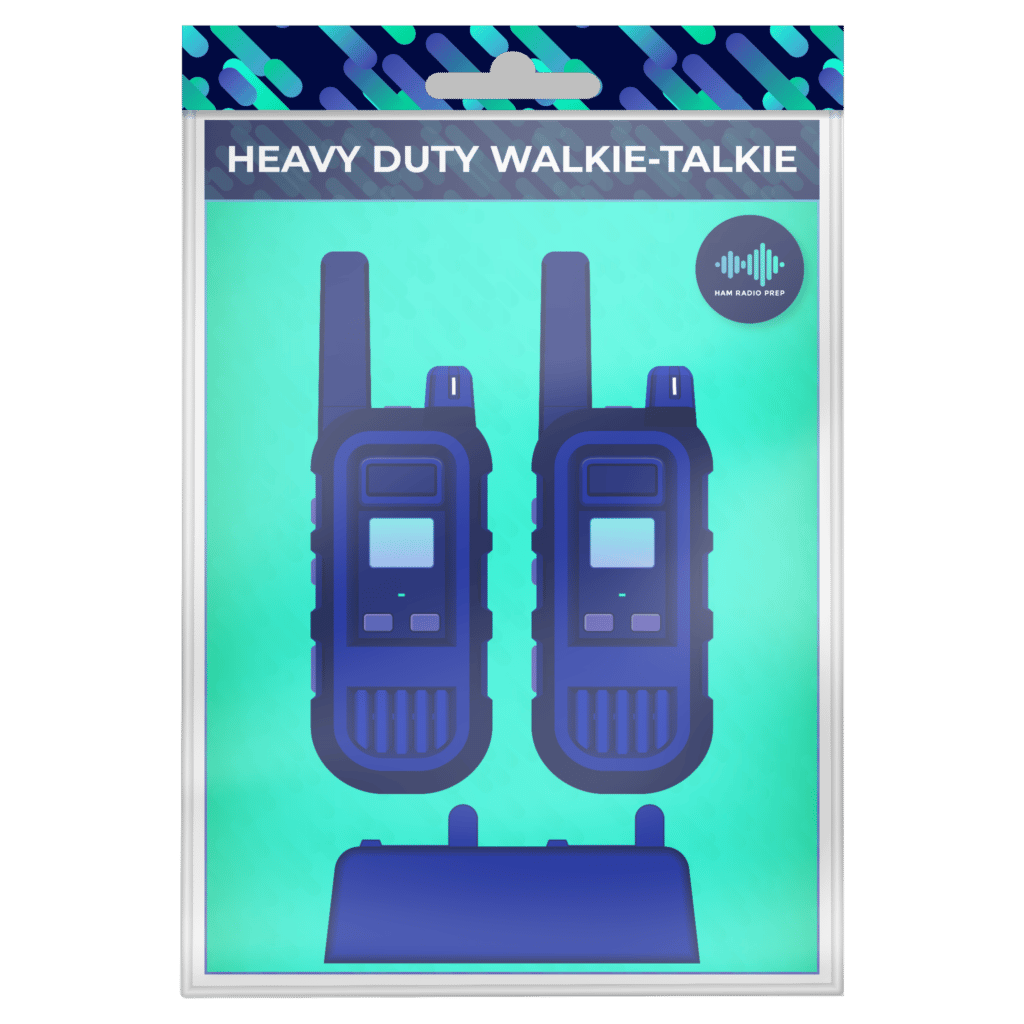Ham Radio Range
A Guide to How Far You Can Talk
By Ham Radio Prep
One of the most frequent questions that newcomers to amateur radio ask is, “How far can you talk on ham radio? One answer is “all around the world.” An equally common, but equally vague, answer is, “It depends.”
Your range on ham radio starts at 5 miles with a simple handheld and extends all the way around the world once you have the right license and equipment.
The distance a signal will reach depends on a lot of things, including:
- The frequency you’re transmitting on.
- Your transmitter’s output power.
- The type of antenna you’re using.
- Propagation conditions.
Level 1
Technician License Course
Take a free 5-minute lesson to take the first step to getting licensed.

The most powerful radio service available
If you’re considering getting your ham radio license or you’re trying to choose a radio service that’s right for you, the answer is simple – amateur radio, also known as ham radio – has the longest range, most power, and most flexibility of any radio service that is available to the general public, once you get a license. Your range on ham radio starts at 5 miles with a simple handheld and extends all the way around the world once you have the right license and equipment.

The potential reach and power of ham radio is exactly why a license is required! Because amateur radio allows for so much power and flexibility, it’s important that ham operators know the rules and regulations to avoid interference with military and commercial communications. With great power comes great responsibility, which is why it’s so important to get your license.
We’re frequently asked to compare ham radio to services like GMRS, FRS, and CB radio. Let’s start with GMRS.
Ham Radio vs GMRS Range
The General Mobile Radio Service or GMRS is a UHF band service that is second only to ham radio in power, and like ham radio also requires a license. This license is a family one compared to the individual ham license. GMRS allows voice and simple short messaging, but limited to 50 watts of power. Compare that to a ham with their Amateur Extra license, who can use up to 1500 watts on some frequencies. That’s 30 times more powerful than GMRS. In fact, 1500 watts is more power than some AM broadcast stations at night!
Ham Radio vs FRS Range
FRS, also called Family Radio Service, has only half a watt of power, which means you are going to max out at a range of about two miles. It actually shares some frequencies with GMRS, but because it’s low power you don’t need a license. These are the kind of radios you see in plastic packs in the big box store.

Ham Radio vs CB Radio Range
CB radio has been an unlicensed service since the 70’s because its power is limited to 4 watts. Using CB at maximum power down around 27 megahertz, you’ll get about 3-4 miles range.
| Radio Service | Maximum Power | License Required? | Maximum Range |
| Ham Radio aka Amateur Radio | 1500 Watts (see band plans for full details) | Yes | Worldwide and even space |
| GMRS | 50 watts | Yes | ~30 miles |
| CB | 4 watts | No | 3-4 miles |
| FRS | 0.5 watts | No | 1-2 miles (across the park) |
So now that you know about the other services, let’s talk about some of the different ham radio operating options and what range you might see.
Local Communications with Technician
Your first level Amateur Radio license will get you to what’s called the Technician level. The focus of this level is mostly local communications, but that doesn’t mean you can’t talk to people globally.
Most people will start with a handheld like one of these. You can talk walkie talkie style to friends across a park or down the street, we call that simplex communications. Distance using the most popular frequency bands maxes out around 5 miles, with radio size and battery limiting you. Don’t worry if that seems low, we have a lot more tools for you.
| Radio | Mode | Distance |
| Handheld | FM Simplex | ~ 5 Miles |
Mobile Radio
Let’s bump up the radio next. Graduating to a mobile radio will get you more distance. Those are typically powered by a car or external power supply. Basic power goes up to 50 watts here. Imagine you’re at the top of a mountain with a nice line of sight. Using a mobile ham radio you can easily expect to communicate 50 miles or more.
| Radio | Mode | Distance |
| Handheld | FM Simplex | ~ 5 Miles |
| Mobile | FM Simplex | ~ 50 Miles line of site |
So far we have been talking simplex, unassisted communications. Let’s introduce repeaters. These are unmanned radios hams have taken a great deal of their own time and expense to place at high points around communities. You send in a signal on an input frequency and your message is repeated on a slightly different frequency across your city or county. Depending on the repeater power, height and other factors, we’re at around 50 miles of range again.
| Radio | Mode | Distance |
| Handheld | FM Simplex | ~ 5 Miles |
| Mobile | FM Simplex | ~ 50 Miles line of site |
| Handheld or Mobile | FM Repeater | ~ 50 miles from the repeater |
Extending your range with Repeaters & Digital
So, we’ve reached the point where you can consistently be heard around your city or county. Now, let’s let the repeaters talk to each other. This is called a linked repeater network which may allow you to talk all the way up the coast of California or from Mississippi to Tennessee. Let’s call that range up to 500 miles.
| Radio | Mode | Distance |
| Handheld | FM Simplex | ~ 5 Miles |
| Mobile | FM Simplex | ~ 50 Miles line of site |
| Handheld or Mobile | FM Repeater | ~ 50 miles from the repeater |
| Handheld or Mobile | Linked Repeater | ~ 500 miles when available |
Finishing up with repeaters, some repeater owners have connected their repeaters to digital networks over the internet allowing them to have discussions around the world. With names like DMR, DStar and Fusion, the right combination of digital radio, operating mode, and repeater could get your voice transmitted worldwide.
| Radio | Mode | Distance |
| Handheld | FM Simplex | ~ 5 Miles |
| Mobile | FM Simplex | ~ 50 Miles line of site |
| Handheld or Mobile | FM Repeater | ~ 50 miles from the repeater |
| Handheld or Mobile | Linked Repeater | ~ 500 miles when available |
| Digital Radio | Digital Repeater | Worldwide |
Communicating with Satellites
So, we’ve covered the opportunities using repeaters on earth. With the introduction of a directional antenna, we’ll open up the sky. The typical stick antenna you see on the back of a car can be modified to direct more of a signal in a single direction and this antenna is called a Yagi.
A Yagi antenna opens up access to amateur radio dedicated satellites. It’s easy to think of this as a “space repeater” and hams have been building them and getting them launched into orbit for more than 60 years. In addition to the stand alone satellites, there is a space based repeater attached to the International Space Station.
Given the placement of these repeaters high up, you could talk to hams over 1,500 miles when the positions are right, so Texas to Minnesota is totally an option. If you get really lucky while using the ISS repeater, you might get to talk to an astronaut, several of them are hams and jump on from time to time. You can count talking to an astronaut on the ISS as a 250 mile or so contact.
| Radio | Mode | Up To Distance |
| Handheld | FM Simplex | 5 Miles |
| Mobile | FM Simplex | 50 Miles line of site |
| Handheld or Mobile | FM Repeater | 50 miles from the repeater |
| Handheld or Mobile | Linked Repeater | 500 miles when available |
| Digital Radio | Digital Repeater | Worldwide |
| Handheld with Yagi Antenna | Satellite Repeater | 1,500 Miles |
| Handheld with Yagi to ISS Astronaut | FM Simplex | 254 Miles |
Communicating Around the World with HF for Technician Class
As a Technician level ham, there is one more option if you’re looking for worldwide communications with some old school flair. All technician level ham radio licensees have some privileges on the 10, 15, 40 and 80 meter shortwave bands using Morse Code. Learn your dits and dahs, pick up a code key and get your HF radio going. Using up to 200 watts of power, when propagation is right, you’ll communicate around the world.
| Radio | Mode | Up To Distance |
| Handheld | FM Simplex | 5 Miles |
| Mobile | FM Simplex | 50 Miles line of site |
| Handheld or Mobile | FM Repeater | 50 miles from the repeater |
| Handheld or Mobile | Linked Repeater | 500 miles when available |
| Digital Radio | Digital Repeater | Worldwide |
| Handheld with Yagi Antenna | FM Repeater | 1,500 Miles |
| Handheld with Yagi to ISS Astronaut | FM Simplex | 254 Miles |
| High Frequency | CW (Morse Code) | Worldwide |
So your experience with your Technician license will probably start with some pretty short communications but as you grow your skills and explore different opportunities you can definitely talk around the world with the right combination of gear.
Worldwide Communications – Upgrade Your License
If you are interested in even more challenging opportunities, like bouncing your voice off the atmosphere, building your own radios, and experiencing all the other things HF communications have to offer, consider upgrading to the General or Extra license levels. As we mentioned earlier, it offers up to 1,500 watts of power on short wave frequencies which lets you talk around the world with the right equipment.
